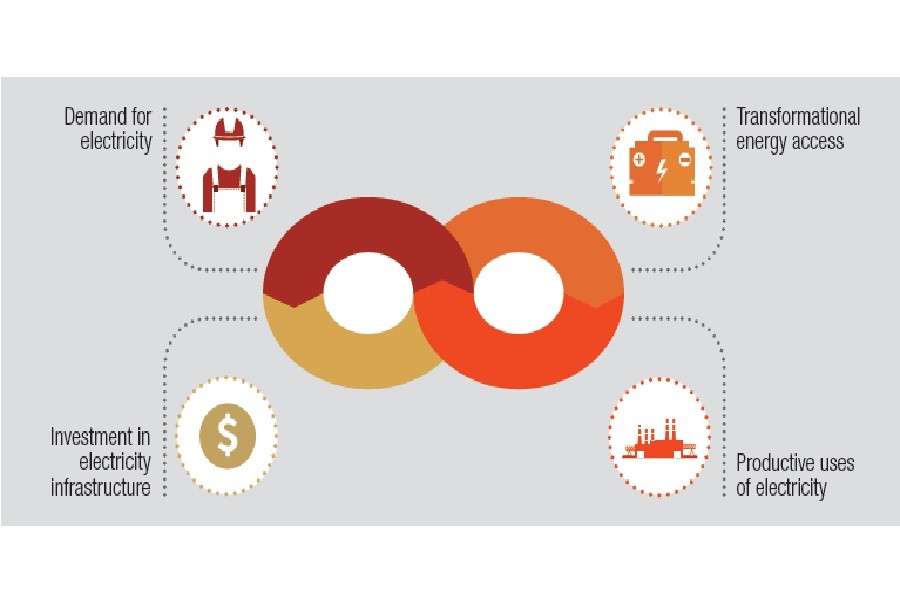Although the government is perpetually upbeat about steps it is taking to address the energy crisis, the fact remains that despite some considerable improvements over the years --especially in the urban locations, the efforts have to go miles before those meet the ever growing industrial and domestic demands.
According to 'The Least Developed Countries Report 2017: Transformational Energy Access' of the UNCTAD (United Nations Conference on Trade and Development) released recently, Bangladesh needs to give 20-30 per cent more new electricity connections a year for achieving the target of energy for all by 2030. The report brings to light the grim reality that half of the country's rural population still doesn't have access to electricity while 90 per cent of them live in rural areas.
There were detailed discussions on the issue at the launching ceremony of the UNCTAD Report organised by the lead think-tank CPD (Centre for Policy Dialogue) in the capital the other day. The highlights of the Report, among others, referred to lack of access to electricity as a serious deterrent to businesses. Based on 2014 data, the Report mentioned that around 53 per cent of companies of the country identified it as a major constraint.
Electrification rates in urban areas is 84 per cent and in rural areas 51 per cent, which are much lower than the world average but higher than the LDC average, the Report said. In general, access to electricity was nearly 60 per cent in Bangladesh in 2014, which was the lowest among all Asian LDCs including Bhutan, Nepal and Laos.
However, according to the Bangladesh Power Division data, access to electricity in the country has risen to around 80 per cent in 2017. At the launching-cum-briefing function, CPD Executive Director clarified that UNCTAD used old data for the purpose of comparison with other LDCs as many of them did not have latest data.
Still, despite the improvements as claimed by the Power Division, the fact that the urban-rural gap in accessing electricity has remained unchanged is a potential challenge for the government to work on.
The Sustainable Development Goals of the United Nations in 2015 set the target of ensuring access to affordable, reliable, sustainable and modern energy for all by 2030 (Goal-7). According to the UNCTAD Report, the LDCs are falling far behind the rest of the developing world in terms of getting power to homes and businesses. While they have made great strides in recent years, achieving the global goal of universal access to energy by 2030 will require a 3.5 times increase in their annual rate of electrification.
As per the Report, almost two-thirds or 61 per cent of energy in Bangladesh are used in the residential sector followed by the industrial sector - 21 per cent, transport sector-11 per cent and agriculture sector - only 4.0 per cent.
Expanding access to adequate, reliable and affordable modern energy is essential if the LDCs are to escape the poverty trap, said the report. The world's 47 LDCs, nine from Asia, are falling far behind the rest of the developing world in terms of getting power to homes and businesses, it said.
The report makes some pointed observations on the overall electricity scenario in the LDCs. More than 40 per cent of businesses operating in the LDCs, according to the Report, are held back by inadequate, unreliable and unaffordable electricity. On an average, they suffer 10 power outages per month, each lasting around five hours, and this costs them 7.0 per cent of the value of their sales. Given this situation, achieving universal access to modern energy in LDCs by 2030 will be costly. Based on previous global estimates, the report puts the cost at $12 billion to $40 billion per year. Transformational energy access would cost still more.
That the government needs a major thrust to investment to bring a semblance of equity in reducing urban-rural gap while simultaneously feeding the power-starved business, especially the manufacturing sector, is pretty well known. However, it is the planning as to how to go about matters most. Energy experts in the country have time again pointed to the highly costly oil-run rental power plants as white elephants-obviously referring to the other means of generating electricity, cheaply and sustainably. Before mulling on newer power plants, there is an urgent need for the government to go for well-meaning, structured dialogues with experts. Since generating 20-30 per cent more electricity each year involves staggering amount of funds, all the nation can look up to is a sound roadmap for the future. The government has to move cautiously.


